Australo-Papuan Brown Snakes

Distribution map of Brown snakes
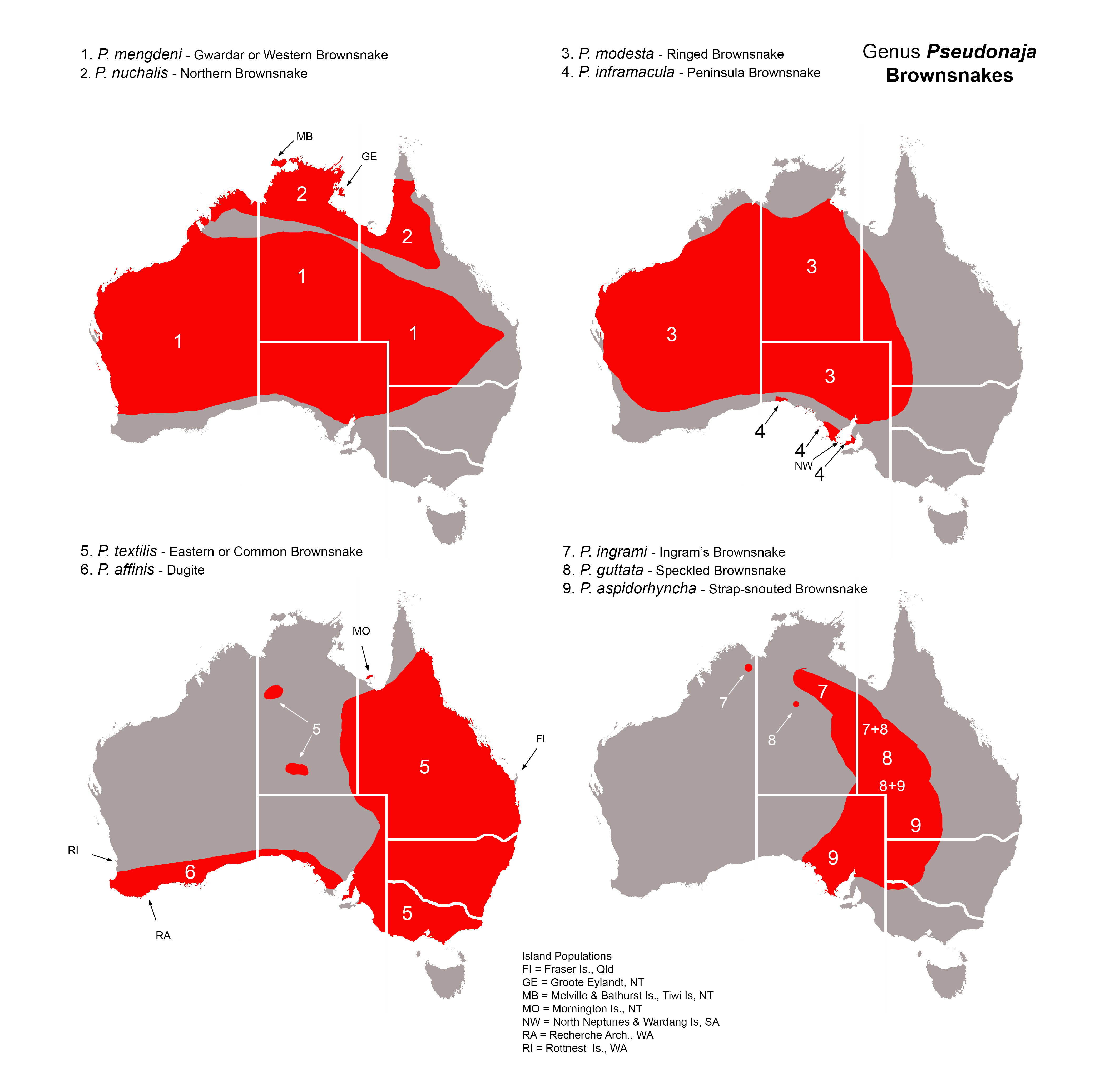
The brown snakes are the most medically relevant genus of venomous snakes in Australia and have caused more than half of all serious snakebite (and over 60% of snakebite death) in Australia over the past few decades. Brown snakes are highly adaptable and, as numbers of others species like tiger snakes (Notechis scutatus) have declined following human modification of the environment, brown snake numbers have increased, particularly in rural areas. One obvious reason for this is the fact that adult brown snakes of most species, whilst generalists, feed predominantly on small mammals, particularly rodents. The taxonomy of the genus remains controversial, but 9 species are widely recognised, and the genus is distributed across the entirety of the Australian mainland. One species, the eastern brown snake (Pseudonaja textilis) also occurs in New Guinea. Despite the common name, “brown snakes” are not always brown in colour, and may be grey, black, yellow, or bright orange. Most species contain both patterned (banded or speckled) and unmarked individuals, and several species commonly have black heads.
Brown snakes have a reputation for being highly strung, and will not hesitate to bite defensively if they feel threatened. Most species in the genus exhibit a classic defensive posture, with the head held up off the ground, the neck bent (often into an “S-shape”) and the mouth wide open. They are extremely sensitive to movement, with the consequence that they may, if cornered, lunge open-mouthed at any object that moves close to them. On the other hand, they appear to quickly forget about perceived threats that cease to move, with the consequence that if one accidentally corners an agitated brown snake the safest response is to remain still. Given the opportunity, brown snakes, like most venomous snakes, will quickly head for shelter and should not be considered “aggressive” – humans are much larger than venomous snakes and are thus perceived as predators, not prey, and snakes can rarely be said to “attack” humans. The fangs of brown snakes are very short and sturdy footwear and long pants made of coarse fabric like denim afford a considerable (though not guaranteed) degree of protection against brown snake bites. The venom yields of brown snakes are also very small, but the venom is extremely potent and even a bite that does not result in a visible wound may cause a life-threatening envenomation. For this reason, any contact between the head of a brown snake and bare skin should be considered a life-threatening emergency requiring immediate first aid and transfer to hospital for diagnosis and (if necessary) antivenom therapy.
Distribution: Mainland Australia, also southern New Guinea.
Distinguishing characteristics: Body slender, with smooth scales in 17-19, rarely 21, rows at midbody, head rounded, eyes with round pupils, cloacal plate and subcaudals divided, temporolabial scale absent.
Australian species: Pseudonaja affinis, P. aspidorhyncha, P. guttata, P. inframacula, P. ingrami, P. mengdeni, P. modesta, P. nuchalis, P. textilis.
International species: P. textilis in southern New Guinea.
Habitat: Brown snakes occur in most habitat types in Australia, but favour open habitats including semi-arid to arid areas. Certain species have become very abundant in rural areas and are often encountered close to human habitations, where they search for rodents. Specimens found in humid, closed-canopy habitats may be transient , and in particularly hot and dry summers on the east coast of Queensland. P. textilis appear to make an altitudinal migration, as many more specimens are encountered in forested areas on low-altitude mountain ranges during these periods.
Activity: Varies from species to species and throughout life history. Adults of larger species are primarily diurnal, but may become nocturnal or crepuscular in hot weather. Adult P. modesta and P. nuchalis in the tropical north, are more commonly encountered at night, and juveniles of all species may forage nocturnally. Classically, brown snakes may adopt an open-mouthed S-shape defensive stance when they feels threatened.
Diet: Most species are generalists as adults, juveniles are lizard specialists, as is adult P. modesta. P. guttata appears to feed primarily on frogs.Other species take a wide variety of vertebrates, including lizards, snakes, small mammals, and ground-dwelling birds, occasionally frogs. There is an allometric (size-related) trend documented in the diet of brown snakes, with larger species including increasing percentages of mammals in their diet. Large adult P. affinis and P. textilis may almost be considered mammal specialists.
Reproduction: Oviparous, with a wide range of clutch sizes.
Venom: Brown snake venoms are amongst the most potent of any snakes in the world, and P. textilis venom has the second lowest LD50 in rodents of any snake tested. The primary clinical pathology associated with brown snake envenomation is venom-induced consumption coagulopathy, caused by a procoagulant toxin complex present in the venoms of adult snakes of all species with the exception of P. modesta. A major ontogenetic (age-related) and allometric (size-related) shift in the composition of brown snake venoms have been documented, and juveniles appear to lack procoagulant toxins altogether, instead having venoms almost exclusively composed of neurotoxins (3FTx), phospholipase A2 (which may be myotoxic, anticoagulant or presynaptically neurotoxic) and other low molecular weight components. Neurotoxins are present in the venoms of all brown snake species at all ages, although clinical relevant neurotoxicity is a rare consequence of bites to humans, a fact known as the “brown snake paradox”. One of the most alarming occasional consequences of brown snake envenomation, which occurs in a majority of fatal cases, is “early collapse”, in which bite victims collapse within an hour (sometimes within 30 minutes) of the bite. The precise mechanism of this cardiovascular collapse syndrome has not been elucidated and it may result from interactions between a number of toxin types and the homeostatic systems of the bite victim.
The recommended treatment for brown snake envenomation is Seqirus (bioCSL) Brown Snake Antivenom (BSAV), and, as with all potentially life-threatening envenomations, early administration of antivenom is desirable, in order to shorten hospital stays and reduce the risk of further complications.
Pseudonaja affinis Günther, 1872
Dugite
Distribution: SA (Nullabor Coast); WA (south coast).
Islands: Recherche Archipelago (P. a. tanneri), & Rottnest Is (P. a. exilis), WA.
Length: 1.5 - 2.0 m (island subspecies 1.1 m)
Distinguishing characteristics: Dorsal scales smooth, in 17 rows (east) or 19, rarely 21, rows (west) at midbody; ventrals 190-230; cloacal plate divided; subcaudals 50-70, all paired; six supralabials; temporolabial absent.
Colouration & patterning: Dorsum light brown, dark brown, or black with light or heavy speckling with black, juveniles with black head and nape markings; venter yellow olive with dark speckling and orange blotches, or uniformly dark.
Habitat: Coastal dunes, semi-arid woodland, wet sclerophyll forest, heathlands and arid scrubland.
Activity: Primarily diurnal, crepuscular or nocturnal in hot weather, will adopt an S-shaped, hooded, defensive stance when it feels threatened.
Diet: Like other large species of brown snake, dugites are generalists that undergo an allometric (size-related) shift in diet from predominantly lizards (as juveniles) to predominantly mammals (as adults). Island populations, taking advantage of available prey types, primarily feed upon lizards.
Reproduction: Oviparous, with clutches averaging 15 eggs.
Pseudonaja aspidorhyncha (McCoy, 1879)
Strap-snouted Brown snake
Distribution: NSW (northwest); NT (extreme southeast); Qld (southwest); SA (southeast & east); Vic (extreme northwest).
Length: 1.3 - 1.5 m
Distinguishing characteristics: Dorsal scales smooth, in 17, rarely 19, rows at midbody; ventrals 200-230; cloacal plate divided; subcaudals 45-70, all paired; six supralabials; temporolabial absent; enlarged rostral scale.
Colouration & patterning: Dorsum variable, brown or grey with dark speckling or irregular dark banding; venter grey, yellow, or cream, with dark speckling and orange blotching, underside of throat and neck may be black.
Habitat: Arid stony desert or dry woodland.
Activity: Primarily diurnal, crepuscular or nocturnal in hot weather, will adopt an S-shaped, hooded, defensive stance when it feels threatened.
Diet: A generalist that feeds on lizards, snakes, small mammals, and small birds.
Reproduction: Oviparous, with clutches averaging ten eggs.
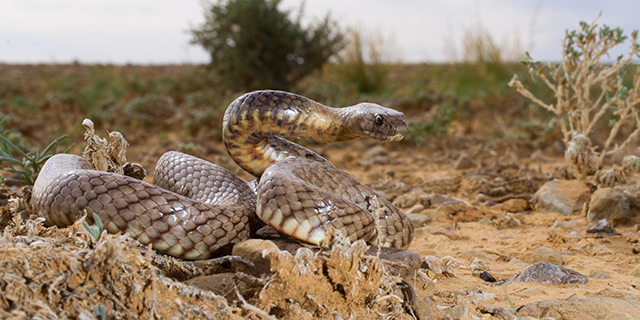
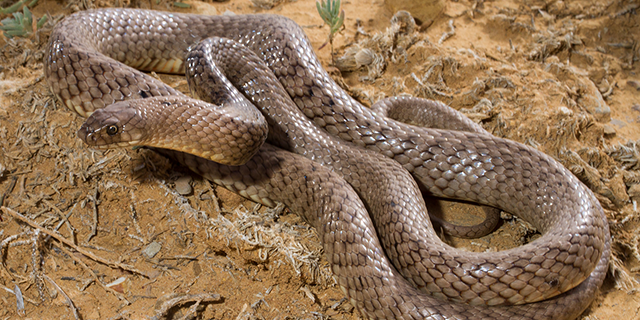
Pseudonaja guttata (Parker, 1926)
Speckled Brown snake
Distribution: NT (east); Qld (south-central & west); SA (extreme northeast), isolated or relict population in north-central NT.
Length: 0.5 - 0.8 m, occasionally 1.4 m
Distinguishing characteristics: Dorsal scales smooth, in 19-21 rows at midbody; ventrals 190-230; cloacal plate divided; subcaudals 45-70, all paired; six supralabials; temporolabial absent.
Colouration & patterning: Dorsum orange-brown to grey-brown, darkly banded, blotched or speckled; venter yellow or orange, with orange blotches, and sometimes a black band on the white throat.
Habitat: Arid grasslands on a clay substrate or black-soil plains.
Activity: Primarily diurnal, crepuscular or nocturnal in hot weather, will adopt an S-shaped, hooded, defensive stance when it feels threatened.
Diet: Unusually for a brown snake, the speckled brown appears to feed primarily on frogs as an adult, only occasionally taking lizards and small mammals.
Reproduction: Oviparous, with small clutches averaging six eggs.
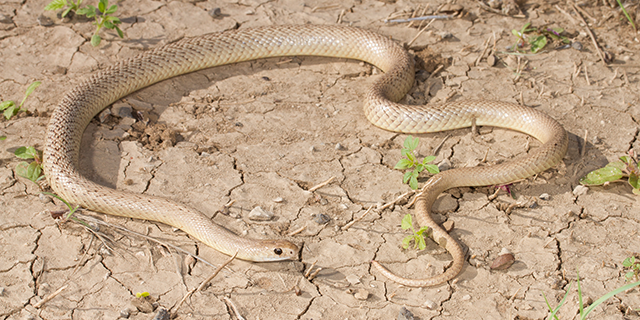
Pseudonaja inframacula (Waite, 1925)
Peninsula Brown snake
Distribution: (Yorke & Eyre Peninsulas), SA with an isolated population on the Nullabor Coast.
Islands: North Neptunes & Wardang Is., Spencer Gulf, SA
Length: 1.2 - 1.6 m
Distinguishing characteristics: Dorsal scales smooth, in 17 rows at midbody; ventrals 190-230; cloacal plate divided; subcaudals 50-65, mostly paired, occasionally a few single; six supralabials; temporolabial absent.
Colouration & patterning: Dorsum black, brown or yellow-brown, with dark scale edging forming a reticulate pattern, and dark speckling; venter grey, except for cream chin.
Habitat: Arid or semi-arid mallee woodland, scrubland, and sandy heathlands.
Activity: Primarily diurnal, crepuscular or nocturnal in hot weather, will adopt an S-shaped, hooded, defensive stance when it feels threatened.
Diet: A generalist that feeds on frogs, lizards, small mammals, and reptile eggs.
Reproduction: Oviparous, with clutches averaging ten eggs.
Pseudonaja ingrami (Boulenger, 1908)
Ingram’s Brown snake
Distribution: Qld (Mt Isa & west); NT (Barkly Tableland, eastern-central); possible isolated relict population at Kununurra, WA.
Length: 1.2 - 1.8 m
Distinguishing characteristics: Dorsal scales smooth, in 17 rows at midbody; ventrals 190-220; cloacal plate divided; subcaudals 55-70, all paired; six supralabials; temporolabial absent.
Colouration & patterning: Dorsum yellow-brown, red-brown or dark brown, paler on head and neck; venter cream with lateral orange blotches.
Habitat: Lowland seasonally flooded grasslands on clay or black-soil substrates.
Activity: Primarily diurnal, crepuscular or nocturnal in hot weather, will adopt an S-shaped, hooded, defensive stance when it feels threatened.
Diet: A generalist that primarily feeds upon small mammals as an adult.
Reproduction: Oviparous, with clutches of 5-15 eggs.
Pseudonaja mengdeni Wells & Wellington, 1985
Gwardar or Western Brown snake
Distribution: NSW (northwest); Qld (south & west); SA (excluding south); NT (excluding north); WA (excluding north & south).
Length: 1.2 - 2.0 m
Distinguishing characteristics: Dorsal scales smooth, in 17, occasionally 19, rows at midbody; ventrals 180-230; cloacal plate divided; subcaudals 45-70, all paired; six supralabials; temporolabial absent; enlarged rostral scale.
Colouration & patterning: Dorsum highly variable with many colour “morphs”, including a black-headed orange phase, reticulate pattern, various shades of brown with irregular narrow dark crossbands, or light brown with broad dark bands and a series of three narrow dark bands in the pale interspaces; venter grey to cream with dark grey or orange blotches.
Habitat: Grasslands, sclerophyll forest, arid woodland, scrubland, sand dunes and deserts.
Activity: Primarily diurnal, crepuscular or nocturnal in hot weather, will adopt an S-shaped, hooded, defensive stance when it feels threatened.
Diet: A generalist that feeds on small mammals, ground-nesting birds, and lizards.
Reproduction: Oviparous, with clutches up to twelve eggs.
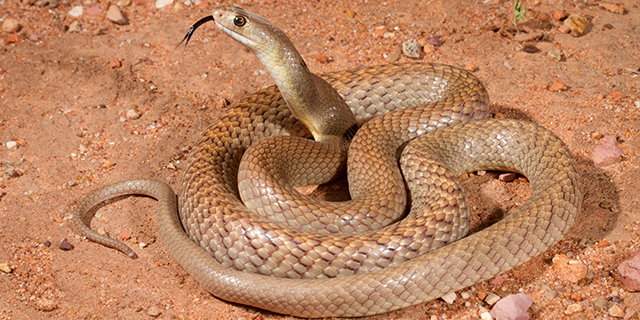
Pseudonaja modesta (Günther, 1872)
Ringed Brown snake
Distribution: NSW (extreme northwest); NT (excluding north & northeast); Qld (southwest & west); SA (excluding south); WA (excluding north & south).
Length: 0.5 - 0.6 m
Distinguishing characteristics: Dorsal scales smooth, in 17 rows at midbody; ventrals 145-175; cloacal plate divided; subcaudals 35-55, all paired; six supralabials; temporolabial absent.
Colouration & patterning: Dorsum brown with black head and nape band, and narrow, widely spaced, black bands on the body; bolder in juveniles than adults; venter cream, blotched with orange.
Habitat: Arid scrubland and grasslands.
Activity: Frequently encountered at night, but diurnal in cooler weather.
Diet: An apparent specialist that feeds almost exclusively on lizards, even as an adult.
Reproduction: Oviparous, with clutches of 6-11 eggs.
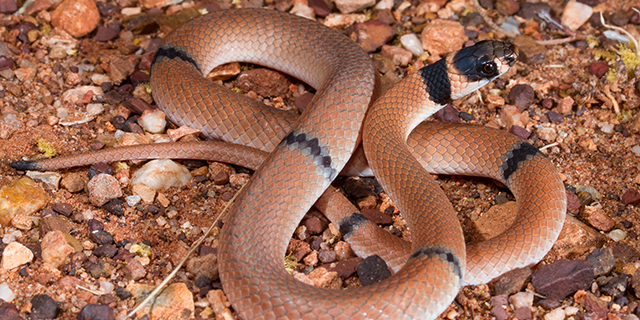
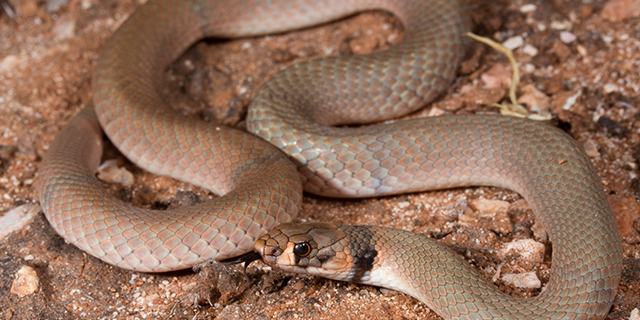
Pseudonaja nuchalis Günther, 1858
Northern Brown snake
Distribution: NT (Top End & Gulf of Carpentaria); Qld (Cape York); WA (Kimberley).
Islands: Melville & Bathurst Is, Tiwi Is, Groote Eylandt, NT.
Length: 1.3 - 1.5 m.
Distinguishing characteristics: Dorsal scales smooth, in 17, occasionally 19, rows at midbody; ventrals 180-230; cloacal plate divided; subcaudals 50-70, all paired; six supralabials; temporolabial absent; enlarged rostral scale.
Colouration & patterning: Dorsum various shades of brown, with black speckling or reticulation, often darker on the anterior body, pale on the snout, or uniform brown or black; venter cream to white with orange blotches.
Habitat: Tropical savannah woodland, and vegetated rocky outcrops.
Activity: Frequently encountered at night, but also diurnally active, may adopt an S-shaped, hooded, defensive stance when it feels threatened.
Diet: Frogs, lizards, snakes, and small mammals.
Reproduction: Oviparous, with clutches of 9-14 eggs, occasionally up to 38 eggs.
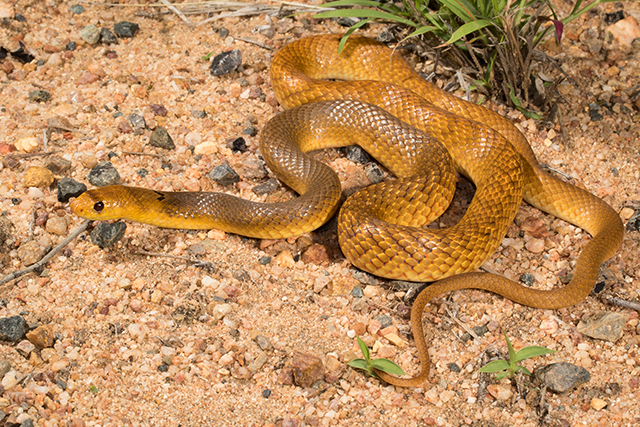
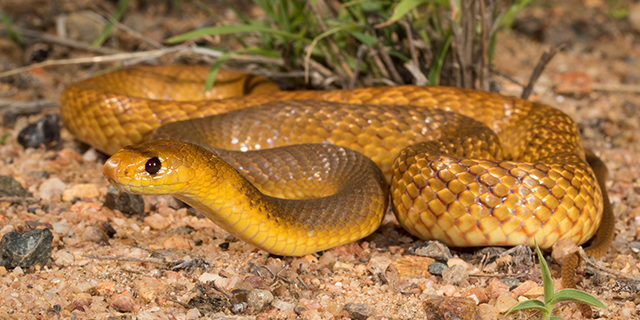
Pseudonaja textilis (Duméril, Bibron & Duméril, 1854)
Eastern or Common Brown snake
Distribution: ACT; NSW (entire); NT (east); QLD (excluding Cape York); SA (east, northeast & southeast); Vic (entire), with isolated relict populations in southern and central-western NT.
International: Southern New Guinea (Trans-Fly of PNG/West Papua, & Papuan Peninsula).
Islands: Mornington Is & Fraser Is, Qld.
Length: 1.5 - 2.0 m
Distinguishing characteristics: Dorsal scales smooth, in 17 rows at midbody; ventrals 185-235; cloacal plate divided; subcaudals 45-75, mostly paired, occasionally a few single; six supralabials; temporolabial absent.
Colouration & patterning: Dorsum of adults uniform light or dark brown, dark grey, black, or orange or speckled with dark pigment, juveniles pale brown or orange, often with regularly spaced narrow black bands, broad black nape and black cap to head; venter cream, yellowish, pale brown or grey, with orange or brown spots.
Habitat: A wide range of habitats from grassland to woodland, sparse or closed canopy, sclerophyll forest, coastal heathland, around human habitations, and oil palm plantations (PNG).
Activity: Primarily diurnal, crepuscular or nocturnal in hot weather, will adopt an S-shaped, hooded, open-mouthed defensive stance when it feels threatened.
Diet: A lizard specialist as a juvenile and a generalist as an adult, feeding increasingly on mammals as it increases in size. Ultimately an opportunist that will also feed on other snakes and ground-nesting birds.
Reproduction: Oviparous, with clutches of 8-35 eggs.




